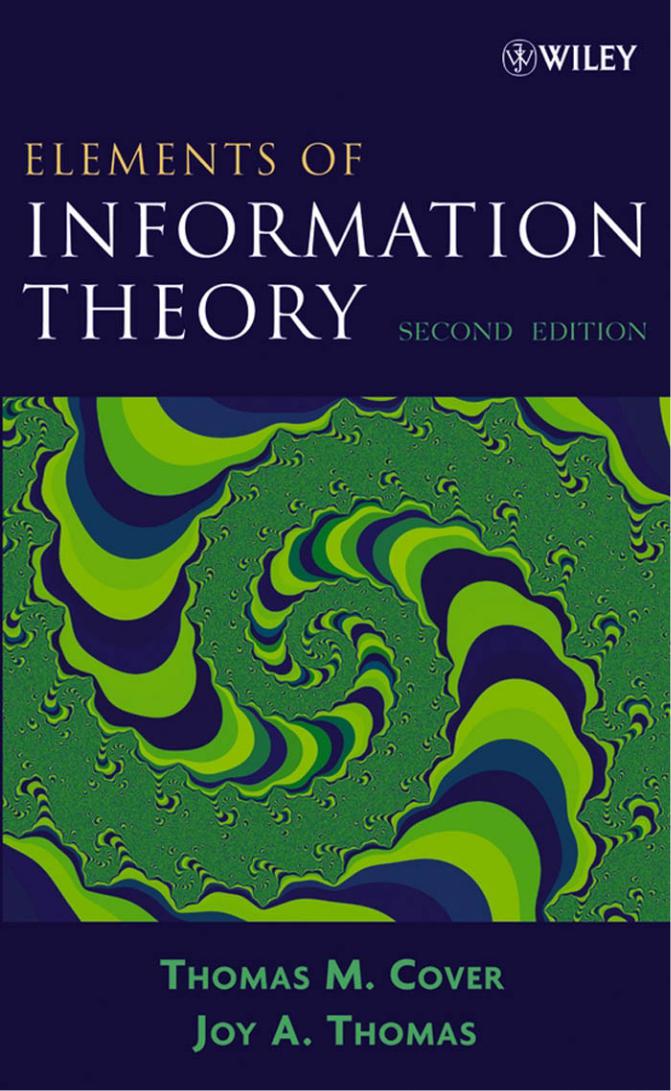
Теория информации / Cover T.M., Thomas J.A. Elements of Information Theory. 2006., 748p
.pdf

ELEMENTS OF INFORMATION THEORY
Second Edition
THOMAS M. COVER
JOY A. THOMAS
A JOHN WILEY & SONS, INC., PUBLICATION
ELEMENTS OF INFORMATION THEORY

ELEMENTS OF INFORMATION THEORY
Second Edition
THOMAS M. COVER
JOY A. THOMAS
A JOHN WILEY & SONS, INC., PUBLICATION
Copyright 2006 by John Wiley & Sons, Inc. All rights reserved.
Published by John Wiley & Sons, Inc., Hoboken, New Jersey.
Published simultaneously in Canada.
No part of this publication may be reproduced, stored in a retrieval system, or transmitted in any form or by any means, electronic, mechanical, photocopying, recording, scanning, or otherwise, except as permitted under Section 107 or 108 of the 1976 United States Copyright Act, without either the prior written permission of the Publisher, or authorization through payment of the appropriate per-copy fee to the Copyright Clearance Center, Inc., 222 Rosewood Drive, Danvers, MA 01923, (978) 750-8400, fax (978) 750-4470, or on the web at www.copyright.com. Requests to the Publisher for permission should be addressed to the Permissions Department,
John Wiley & Sons, Inc., 111 River Street, Hoboken, NJ 07030, (201) 748-6011, fax (201) 748-6008, or online at http://www.wiley.com/go/permission.
Limit of Liability/Disclaimer of Warranty: While the publisher and author have used their best efforts in preparing this book, they make no representations or warranties with respect to the accuracy or completeness of the contents of this book and specifically disclaim any implied warranties of merchantability or fitness for a particular purpose. No warranty may be created or extended by sales representatives or written sales materials. The advice and strategies contained herein may not be suitable for your situation. You should consult with a professional where appropriate. Neither the publisher nor author shall be liable for any loss of profit or any other commercial damages, including but not limited to special, incidental, consequential, or other damages.
For general information on our other products and services or for technical support, please contact our Customer Care Department within the United States at (800) 762-2974, outside the United States at (317) 572-3993 or fax (317) 572-4002.
Wiley also publishes its books in a variety of electronic formats. Some content that appears in print may not be available in electronic formats. For more information about Wiley products, visit our web site at www.wiley.com.
Library of Congress Cataloging-in-Publication Data:
Cover, T. M., 1938–
Elements of information theory/by Thomas M. Cover, Joy A. Thomas.–2nd ed. p. cm.
“A Wiley-Interscience publication.”
Includes bibliographical references and index. ISBN-13 978-0-471-24195-9
ISBN-10 0-471-24195-4
1. Information theory. I. Thomas, Joy A. II. Title. Q360.C68 2005
003 .54–dc22
2005047799
Printed in the United States of America.
10 9 8 7 6 5 4 3 2 1

CONTENTS
Contents |
|
v |
|
Preface to the Second Edition |
xv |
||
Preface to the First Edition |
xvii |
||
Acknowledgments for the Second Edition |
xxi |
||
Acknowledgments for the First Edition |
xxiii |
||
1 |
Introduction and Preview |
1 |
|
|
1.1 |
Preview of the Book 5 |
|
2 |
Entropy, Relative Entropy, and Mutual Information |
13 |
|
2.1Entropy 13
2.2 |
Joint Entropy and Conditional Entropy 16 |
2.3 |
Relative Entropy and Mutual Information 19 |
2.4Relationship Between Entropy and Mutual Information 20
2.5Chain Rules for Entropy, Relative Entropy, and Mutual Information 22
2.6 |
Jensen’s Inequality and Its Consequences |
25 |
2.7 |
Log Sum Inequality and Its Applications |
30 |
2.8Data-Processing Inequality 34
2.9Sufficient Statistics 35
2.10Fano’s Inequality 37 Summary 41
Problems 43 Historical Notes 54
v
vi |
CONTENTS |
|
|
|
3 |
Asymptotic Equipartition Property |
57 |
||
|
3.1 |
Asymptotic Equipartition Property Theorem |
58 |
|
|
3.2 |
Consequences of the AEP: Data Compression |
60 |
|
|
3.3 |
High-Probability Sets and the Typical Set 62 |
||
|
Summary |
64 |
|
|
|
Problems |
64 |
|
|
|
Historical Notes 69 |
|
||
4 |
Entropy Rates of a Stochastic Process |
71 |
||
4.1Markov Chains 71
4.2Entropy Rate 74
4.3Example: Entropy Rate of a Random Walk on a Weighted Graph 78
4.4 |
Second Law of Thermodynamics |
81 |
|
4.5 |
Functions of Markov Chains 84 |
|
|
Summary |
87 |
|
|
Problems |
88 |
|
|
Historical Notes 100 |
|
||
5 Data Compression |
103 |
||
5.1Examples of Codes 103
5.2Kraft Inequality 107
5.3Optimal Codes 110
5.4 |
Bounds on the Optimal Code Length 112 |
5.5Kraft Inequality for Uniquely Decodable Codes 115
5.6Huffman Codes 118
5.7 |
Some Comments on Huffman Codes 120 |
5.8 |
Optimality of Huffman Codes 123 |
5.9Shannon – Fano – Elias Coding 127
5.10Competitive Optimality of the Shannon Code 130
5.11Generation of Discrete Distributions from Fair Coins 134
Summary 141
Problems 142
Historical Notes 157
CONTENTS vii
6 Gambling and Data Compression |
159 |
6.1The Horse Race 159
|
6.2 |
Gambling and Side Information |
164 |
|
|
6.3 |
Dependent Horse Races and Entropy Rate 166 |
||
|
6.4 |
The Entropy of English 168 |
|
|
|
6.5 |
Data Compression and Gambling |
171 |
|
|
6.6 |
Gambling Estimate of the Entropy of English 173 |
||
|
Summary |
175 |
|
|
|
Problems |
176 |
|
|
|
Historical Notes 182 |
|
||
7 |
Channel Capacity |
183 |
||
|
7.1 |
Examples of Channel Capacity |
184 |
|
7.1.1Noiseless Binary Channel 184
7.1.2Noisy Channel with Nonoverlapping Outputs 185
7.1.3Noisy Typewriter 186
7.1.4Binary Symmetric Channel 187
7.1.5Binary Erasure Channel 188
7.2Symmetric Channels 189
7.3 |
Properties of Channel Capacity 191 |
7.4 |
Preview of the Channel Coding Theorem 191 |
7.5Definitions 192
7.6Jointly Typical Sequences 195
7.7Channel Coding Theorem 199
7.8Zero-Error Codes 205
7.9Fano’s Inequality and the Converse to the Coding Theorem 206
7.10Equality in the Converse to the Channel Coding Theorem 208
7.11Hamming Codes 210
7.12Feedback Capacity 216
7.13Source – Channel Separation Theorem 218 Summary 222
Problems 223 Historical Notes 240
viii CONTENTS
8 Differential Entropy |
243 |
8.1Definitions 243
8.2 |
AEP for Continuous Random Variables 245 |
8.3Relation of Differential Entropy to Discrete Entropy 247
8.4 |
Joint and Conditional Differential Entropy |
249 |
8.5 |
Relative Entropy and Mutual Information |
250 |
8.6Properties of Differential Entropy, Relative Entropy, and Mutual Information 252
Summary 256
Problems 256
Historical Notes 259
9 Gaussian Channel |
261 |
9.1Gaussian Channel: Definitions 263
9.2Converse to the Coding Theorem for Gaussian Channels 268
9.3Bandlimited Channels 270
9.4Parallel Gaussian Channels 274
9.5 |
Channels with Colored Gaussian Noise |
277 |
|
9.6 |
Gaussian Channels with Feedback 280 |
|
|
Summary |
289 |
|
|
Problems |
290 |
|
|
Historical Notes 299 |
|
||
10 Rate Distortion Theory |
301 |
||
10.1Quantization 301
10.2Definitions 303
10.3 |
Calculation of the Rate Distortion Function |
307 |
|
||
|
10.3.1 |
Binary Source |
307 |
|
|
|
10.3.2 |
Gaussian Source |
310 |
|
|
|
10.3.3 Simultaneous Description of Independent |
|
|||
|
|
Gaussian Random Variables 312 |
|
|
|
10.4 |
Converse to the Rate Distortion Theorem |
315 |
|
||
10.5 |
Achievability of the Rate Distortion Function 318 |
||||
10.6 |
Strongly Typical Sequences and Rate Distortion |
325 |
|||
10.7 |
Characterization of the Rate Distortion Function |
329 |
|||
